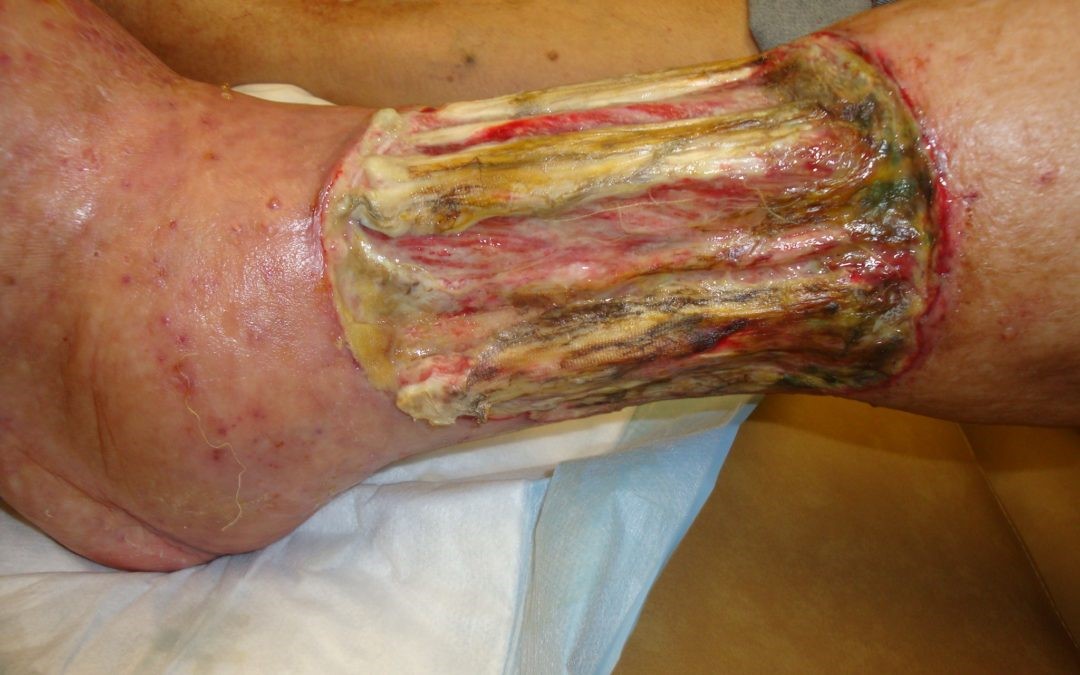In January, I asked for your help with a survey about amputations due to pyoderma gangrenosum (PG). Thanks to all of those who responded, and my apologies that I am asking you to do it again. Let’s just say that there were technical difficulties with the survey (not my fault!)… Here’s the new link to complete it.
There’s a reason we are asking about this. Dr. Alex Ortega has been a godsend to many wound care practitioners left to care for complicated PG patients without help from dermatology or rheumatology. In my 30-plus years of practicing wound care, I have developed an unwelcome amount of experience with Pyoderma gangrenosum. It’s not been uncommon for me to have 8 patients with PG at any given time (and I’m sure I’ve missed some). The problem comes when you try to get a real expert to help you. You find out that you have seen more cases than they have.
PG can range in spectrum from a smoldering but refractory small lesion to a limb threatening debacle. Some patients with PG died of their associated comorbid diseases. In one of my patients, amputation was the best option- but amputation would have been an option for others – if they had lived. This photo is of a patient whose PG was a paraneoplastic syndrome from the sarcoma that took his life.
Many dermatologists have told me they’ve never seen a single case of PG. Wound care practitioners may have more experience with PG than the average dermatologist, and that’s why dermatologist Dr. Alex Ortega-Loyoza has asked for our help.
Dr. Ortega has been researching PG for many years. He recently performed a review of the literature which suggested that PG may lead to amputation far more often than commonly thought. However, his dermatology colleagues were skeptical that this is the case.
The fact is, wound care doctors are a better source of information on this subject than dermatologists. He wrote a guest editorial in my column for Today’s Wound Clinic.
Read Dr. Ortega’s brief editorial on the subject of PG and amputation, and take the quick survey!
If anyone would know the truth about PG and amputation – it’s us.

Dr. Fife is a world renowned wound care physician dedicated to improving patient outcomes through quality driven care. Please visit my blog at CarolineFifeMD.com and my Youtube channel at https://www.youtube.com/c/carolinefifemd/videos
The opinions, comments, and content expressed or implied in my statements are solely my own and do not necessarily reflect the position or views of Intellicure or any of the boards on which I serve.




Hello Dr, Fife.
In the photo, I look at where the skin is not affected and I find that it is covered: either with fat, or with sclerosis, or both. If this is the case for the whole body, there is no possibility of obtaining closure of the wound. Cutaneous clearance becomes crucial, both for hot flashes and for liquid vapor excretion. I suggest you consider Dr. Soo-Kyoung Choi’s study
https://www.dovemed.com/current-medical-news/clearing-damaged-cells-out-body-helps-heal-diabetics-blood-vessels/
By intensively cleansing both arms and legs and the soles of the feet, with an emulsifying product that will break down the hydrophobic barrier of keratinocytes to facilitate the recycling of crusts and cellular debris. the whole body will be refreshed and the pores will be cleared. I am convinced that there, a result will be possible to counter the aggravation of the injury.
This treatment provides two solutions, no less negligible. 1) it helps restore local pressure and temperature, supported by the restorative metabolic system. 2) cleaning the skin restores good communication between the thousands of skin sensors, with the organs that depend on them to decide on the reactions or counter-reactions to develop. And, the medical treatments that come in support are, automatically, more effective. This is the ready-made conclusion of my 35 years of research on chronic injury issues.
My Mom’s leg and ankle look just like that photo. She’s at home and I can’t help but wonder how is this possible that she is supposed to have these opened wounds that are only deteriorating and there is nothing being done about it by doctors (Kaiser). Do you have any suggestions? I feel like she is dying at home.
I have had PG for 10 years it was first misdiagnosed and after after 2 weeks in hospital they let me go with a pot of vasaline! 5 days after I left the hospital you could see the bones in my legs, my foot, my back and there was a large wound on my head. At this point it became an emergancy and to avoid having my left foot and ankle amputated – I agreed to had maggot therapy (which was gross but really worked) then a vac pack bag to suck the wounds so they healed from the bottom up.. I was then placed on sreroids and the immune suppressant Cyclosporine. Nearly 10 years later I am still on immune suppression therapy as my PG attacked my face and badly damaged the inside of my nose, mouth, throat and my eye socket. I also have very very low kidney function, and have regular blood transfusions to control my chronic anemia. PG has totally ruined my life. Does eanybody else have PG attack relapses? And Cyclosporine is toxic but I have not been offered any other medication the 2 they ask me to try were methotrexate which made me non stop sick and my face covered in hives. The other one I didn’t even start as the chemist told me that it can activate shingles – I have had shingles 5 times on my face and twice on my body I take Alciclover every day to control this. Does anybody know if the UK has any specialists in PG? 10 years ago 4 dermatologists misdiagnosed it and it was only when I was rushed back to hospital that the head of the dept correctly diagnosed it. He was unable to find any experts on the condition and I think it’s rare to have repeat attacks but I don’t know because I have never heard from anybody who has or had it.
My mother has had pyoderma gangrenosum for almost 10 years also. In and out of hospital, but most treatment done at home. The few times of extended stay at hospital, almost always resulted in the wound becoming worse, for multiple reasons. Primarily – misdiagnosis initially, and several different doctors, all having contradicting clinical opinions. At one stage, several years ago, the doctor looking after my mother (6 month long stay in hospital), had gone ahead doing debridement of the wound, which led to extreme exacerbation of the primary wound (approx 30cmx20cm, wrapping around lower leg), with multiple (~15) smaller wounds of 5-10cm diameter varying sizes. It was at this stage, following her exacerbation of the wounds condition, she ‘recommended’ amputation. Which we had categorically refused to undertake. It was during this stay, the head Dr had brought in students from the medical university as her condition had become a case study. Rather than any treatment or help, instead the stay was an extended ordeal, and actual treatment of her wound actively continues at home. Albeit, the healing is slow, but daily, active wound management has helped reduce the size to around approx. 20cmx10cm. So far, neither any govt. body, nor our medical system has provided any support, whatsoever. Writing from Australia.
New ulcer formation appears to be characteristic based off both official pathology and our personal experience.
Best of luck to all facing similar circumstances.